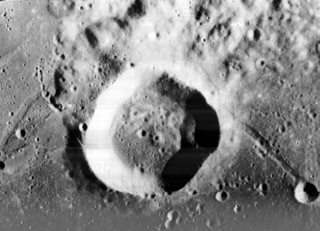
Boethius is a small lunar impact crater located on the east edge of Mare Undarum near the eastern lunar limb. To the southwest is the dark, lava-flooded crater Dubyago.

Bombelli is a small lunar impact crater that is located in the highlands to the north of the Sinus Successus. It was named after Italian mathematician Raphael Bombelli. It was previously designated Apollonius T. The crater Apollonius is located to the east-southeast.

Appleton is a heavily eroded lunar impact crater that lies in the northern hemisphere on the far side of the Moon. To the northwest are the craters Von Neumann and Campbel. The smaller Golovin lies to the northeast, while further to the southwest is the Mare Moscoviense.

Artamonov is a lunar impact crater that is located on the far side of the Moon. The eroded outer rim of Artamonov does not have the circular shape of most lunar craters, and instead has the overall shape of three or four merged craters. The largest of these formations is in the south, with smaller circular bulges to the north and east.

Boss is a lunar impact crater that is located along the northeast rim of the Moon's near side. Due to its location, the crater is viewed from the side by observers on the Earth, and its visibility is subject to libration effects.

Büsching is a lunar impact crater that is located in the crater-covered southern highlands of the Moon. It was named after German geographer Anton F. Büsching. The similar-sized crater Buch is located adjacent to its southwestern rim, and further to the southwest lies Maurolycus.
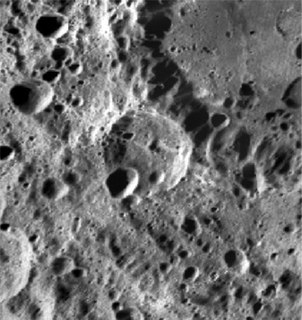
Belyaev is a lunar impact crater that is attached to the outer edge of the Mare Moscoviense, on the far side of the Moon. It is a worn formation with a small crater pair overlaying the southern rim, and several smaller craters across the relatively irregular interior.

Stewart is a small lunar impact crater that lies to the northeast of the Mare Spumans, a small lunar mare near the eastern limb of the Moon. It was named after American astrophysicist John Quincy Stewart. It is located to the north of the crater Pomortsev, and to the southwest of the lava-flooded Dubyago. Stewart was previously designated Dubyago Q before being named by the IAU. This is a circular crater with a low outer rim and a level, featureless interior floor.
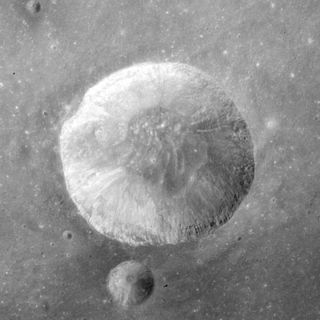
Carmichael is a lunar impact crater that is located along the eastern edge of the Sinus Amoris, in the northeastern quadrant of the Moon's near side. Its diameter is 20 km. It was named after American psychologist Leonard Carmichael. It lies within a couple of crater diameters south-southwest of the smaller crater Hill. Further to the east-northeast is the prominent crater Macrobius. Carmichael was designated Macrobius A before being given its current name by the IAU.
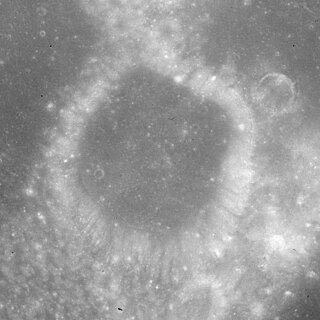
Pomortsev is a small lunar impact crater that is located in the eastern part of the Moon's near side. It was named after Russian rocketry scientist Mikhail Pomortsev. It lies on the eastern edge of Mare Spumans, to the southwest of the crater Dubyago. This formation was previously designated Dubyago P. One crater diameter to the north is the smaller Stewart.
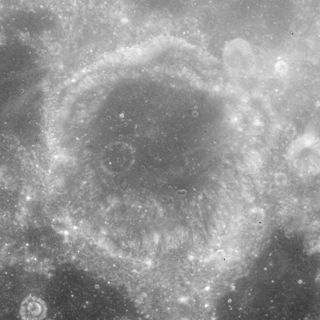
Dubyago is a lunar impact crater that lies in the eastern limb of the Moon. It was named after Russian astronomers Dmitry Dubyago and Alexander Dubyago. It appears significantly foreshortened when viewed from the Earth. It lies along the southern shore of the Mare Undarum, to the southeast of the crater Firmicus.

Dollond is a small lunar impact crater that is located in the central region of the Moon, to the north of the crater Abulfeda. It was named after British optician John Dollond. Due west of Dollond is Anděl. Dollond is circular and cone shaped, with a tiny floor at the midpoint of the sloping interior walls.
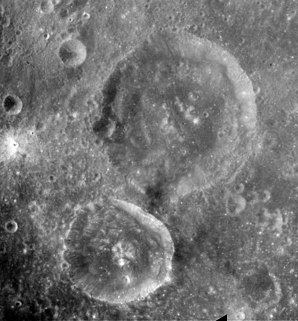
Schubert is a lunar impact crater that lies near the eastern limb of the Moon's near side. The crater is located to the northwest of the Mare Smythii, and southwest of the prominent crater Neper. Nearly attached to the southern rim is the crater Back.

Cysatus is a lunar impact crater that is located in the southern part of the Moon's near side. It is joined to the northeastern rim of the larger crater Gruemberger, and intrudes slightly into the interior of that formation. Due south is the larger Moretus, and to the east is Curtius. These craters appear foreshortened when observed from Earth because of their far south location.

Elmer is a small lunar impact crater that is located to the south of Mare Smythii, near the eastern limb of the Moon. This crater is seen at a highly oblique angle from Earth, and the visibility is affected by libration. Elmer lies southwest of the crater Kreiken, and east-southeast of the larger Dale. This is a circular, bowl-shaped crater with an interior floor that occupies about half the total diameter.

Demonax is a lunar impact crater near the southern limb of the Moon. This location makes the crater difficult to observe due to foreshortening. The crater is also illuminated at a very low angle, when it is in the sunlit side. Demonax lies just to the north of the crater Scott, one of the south polar formations. To the north-northwest is Boguslawsky.

Charlier is a lunar impact crater that is located on the far side of the Moon. To the south-southeast is the larger crater Kovalevskaya, and northeast of Charlier is Perrine.

Einthoven is a lunar impact crater that is located on the far side of the Moon. It is located beyond the region of the surface that is sometimes brought into view due to libration, and so can not be viewed from the Earth. Einthoven is located to the northeast of the huge walled plain Pasteur.

Fleming is a large lunar impact crater that is located on the Moon's far side, and cannot be seen from the Earth. It lies about a crater diameter to the east-northeast of Hertz, and to the northwest of Lobachevskiy.



